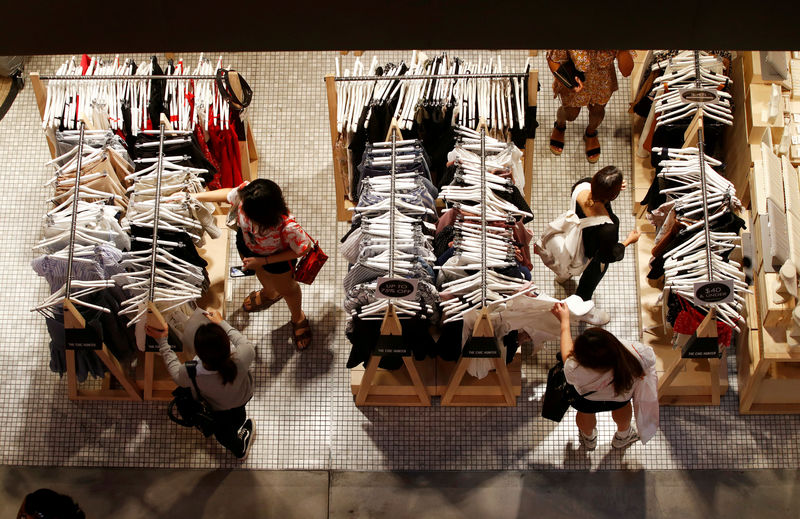 © Reuters. FILE PHOTO: Women shop for clothes on a store in a shopping mall in Sydney
© Reuters. FILE PHOTO: Women shop for clothes on a store in a shopping mall in SydneyBy Wayne Cole
SYDNEY (Reuters) – Australian consumer prices stayed soft last quarter as core inflation began a third year below the central bank’s target, cementing expectations any hike in interest rates is a long distance off.
The local dollar
Annual CPI inflation ran at 1.9 percent, again under estimates. Key measures of underlying inflation favored by the Reserve Bank of Australia (RBA) averaged around 1.9 percent for the year, much as forecast.
Core inflation has now undershot the RBA’s long-term target band of 2 percent to 3 percent for nine straight quarters, the longest period on record.
A major headwind has been wages growth, which slowed to historic lows even as employment boomed, an unwelcome phenomenon shared with much of the developed world.
As a result, the central bank has kept interest rates at an all-time low of 1.5 percent since mid-2016 and sees no strong case for shifting anytime soon.
There is “no particular rush” to hike, RBA Assistant Governor Christopher Kent said earlier on Tuesday. While the next change in interest rate was likely to be up, he said progress on inflation and unemployment was expected to be only gradual.
Interest rate futures imply around a 30 percent chance of a move by December, with 1.75 percent not fully priced in until June next year.
Kent was speaking at a housing conference where he refuted media speculation that the expiry of A$480 billion in interest-only mortgages over the next few years would be akin to the sub-prime crisis in the United States.
PRICE WARS
The Australian Bureau of Statistics (ABS) reported continued disinflation in tradable prices – those that face the most international competition – which fell 0.4 percent in the quarter to be down 0.5 percent on the year.
In contrast, prices of non-tradables which mainly cover services climbed 0.8 percent in the quarter and 3.1 percent for the year.
The main price increases in the March quarter were for education, gas, vegetables, health care and drugs.
Many sector and regulated prices – from transport charges to school fees – tend to rise at the start of the year. Yet even adjusting for those seasonal effects, CPI inflation was still 1.9 percent for the year to March.
The largest price declines came for holidays, tech equipment, furniture and clothing. Clothing alone dropped 2 percent in the quarter due to “competition and discounting activity in the retail industry”, the ABS said.
A fierce price war has broken out in Australian retail in recent years driven by an influx of foreign chains, with no sign of a cease-fire any time soon.
The struggle is only heating up as online behemoth Amazon (NASDAQ:) launched late last year vowing to beat all the competition – a disinflationary trend that policymakers now refer to as the “Amazon effect”.
Fusion Media or anyone involved with Fusion Media will not accept any liability for loss or damage as a result of reliance on the information including data, quotes, charts and buy/sell signals contained within this website. Please be fully informed regarding the risks and costs associated with trading the financial markets, it is one of the riskiest investment forms possible.
Source: Investing.com




























